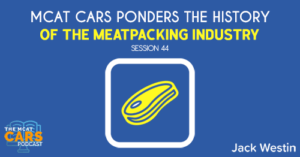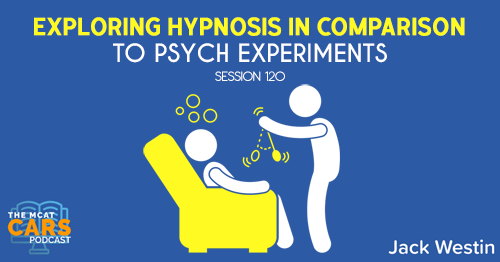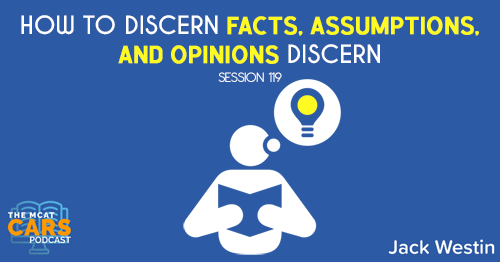Apple Podcasts | Google Podcasts

Session 44
Using your MCAT CARS skills, follow along as we examine a passage that shines a light on the technology and labor issues behind modern meatpacking.
Joined by Jack Westin, the leader in MCAT CARS prep, we’re going to break down yet another passage to help you ace the CARS section of your MCAT.
The passage is very straightforward, but you could easily get lost in the details. The author is establishing the arguments in a storylike passion. Students don’t like this kind of passages as they don’t know which ones are important.
'As long as you can follow through what's going on and have a bigger understanding of what's going on, you should be okay.'Click To TweetListen to this podcast episode with the player above, or keep reading for the highlights and takeaway points.
Link to the article:
The meatpacking mogul Jonathan Ogden Armour could not abide socialist agitators. It was 1906, and Upton Sinclair had just published The Jungle, an explosive novel revealing the grim underside of the American meatpacking industry. Sinclair’s book told the tale of an immigrant family’s toil in Chicago’s slaughterhouses, tracing the family’s physical, financial and emotional collapse. The Jungle was not Armour’s only concern. The year before, the journalist Charles Edward Russell’s book The Greatest Trust in the World had detailed the greed and exploitation of a packing industry that came to the American dining table “three times a day … and extorts its tribute”.
In response to these attacks, Armour, head of the enormous Chicago-based meatpacking firm Armour & Co, took to the Saturday Evening Post to defend himself and his industry. Where critics saw filth, corruption and exploitation, Armour saw cleanliness, fairness and efficiency. If it were not for “the professional agitators of the country”, he claimed, the nation would be free to enjoy an abundance of delicious and affordable meat.
Armour and his critics could agree on this much: they lived in a world unimaginable 50 years before. In 1860, most cattle lived, died and were consumed within a few hundred miles’ radius. By 1906, an animal could be born in Texas, slaughtered in Chicago and eaten in New York. Americans rich and poor could expect to eat beef for dinner. The key aspects of modern beef production – highly centralised, meatpacker-dominated and low-cost – were all pioneered during that period.
For Armour, cheap beef and a thriving centralised meatpacking industry were the consequence of emerging technologies such as the railroad and refrigeration coupled with the business acumen of a set of honest and hard-working men like his father, Philip Danforth Armour. According to critics, however, a capitalist cabal was exploiting technological change and government corruption to bankrupt traditional butchers, sell diseased meat and impoverish the worker.
Ultimately, both views were correct. The national market for fresh beef was the culmination of a technological revolution, but it was also the result of collusion and predatory pricing. The industrial slaughterhouse was a triumph of human ingenuity as well as a site of brutal labour exploitation. Industrial beef production, with all its troubling costs and undeniable benefits, reflected seemingly contradictory realities.
[02:48] Paragraph 1, Sentence 1
The meatpacking mogul Jonathan Ogden Armour could not abide socialist agitators.
Jack says:
The author says Jonathan is a meatpacking mogul, which means he’s a tycoon or a boss. This is what most students often overlook. They overlook the fact that this person has this kind of authority or power. Because they get lost in the last part of the sentence.
'You don't need to know every aspect of a sentence. But you need to know who they're talking about and go with that.'Click To Tweet[04:22] Paragraph 1, Sentence 2
It was 1906, and Upton Sinclair had just published The Jungle, an explosive novel revealing the grim underside of the American meatpacking industry.
Jack says:
They’re educating you on what’s happening and that there are some issues with meatpacking.
[05:16] Paragraph 1, Sentence 3
Sinclair’s book told the tale of an immigrant family’s toil in Chicago’s slaughterhouses, tracing the family’s physical, financial and emotional collapse.
Jack says:
The story is about a bad experience. Words like “toil” and “collapse” are negative words. So you could start forming what’s going on even though we don’t exactly know what “abide socialist agitators” means.
[Related episode: Hear How This Immigrant Got An Acceptance to an Ivy League]
[06:20] Paragraph 1, Sentence 4
The Jungle was not Armour’s only concern.
Jack says:
It says that the book, The Jungle, wasn’t the only thing that Armour had to be concerned about.
[06:40] Paragraph 1, Sentence 5
The year before, the journalist Charles Edward Russell’s book The Greatest Trust in the World had detailed the greed and exploitation of a packing industry that came to the American dining table “three times a day … and extorts its tribute”.
Jack says:
It mentions another book and another author’s name, detailing how bad the meatpacking industry is. It’s saying that people eat three times a day and this is hurting the meatpacking industry.
So we have these two books that are apparently going against meatpacking. And we have this mogul/boss who is trying to resolve this conflict or problem.
At this point, the author of the passage is neutral. A lot of students may confuse the author’s position with the author’s presentation of other authors’ positions. The author never said this is bad or good.
The author is just explaining what’s happening. We have Jonathan Armour and these two authors talking negatively about his business ventures. So we don’t really know where the author stands.
For now, the author is just establishing what’s going on. Just have an open mind while you’re reading this. Take in things from different perspectives and you should be okay.
[09:42] Paragraph 2, Sentence 1
In response to these attacks, Armour, head of the enormous Chicago-based meatpacking firm Armour & Co, took to the Saturday Evening Post to defend himself and his industry.
Jack says:
The author is now saying that Armour is fighting back.
[10:02] Paragraph 2, Sentence 2
Where critics saw filth, corruption and exploitation, Armour saw cleanliness, fairness and efficiency.
Jack says:
Armour was contradicting everything that was talked about in the previous paragraph.
[10:20] Paragraph 2, Sentence 3
If it were not for “the professional agitators of the country”, he claimed, the nation would be free to enjoy an abundance of delicious and affordable meat.
Jack says:
Armour is actually now complaining that these people criticizing his business are actually hurting his business and people.
[11:10] Paragraph 3, Sentence 1
Armour and his critics could agree on this much: they lived in a world unimaginable 50 years before.
Jack says:
The author is showing us how times have changed in 50 years, specifically on what they agree on.
[11:30] Paragraph 3, Sentence 2
In 1860, most cattle lived, died and were consumed within a few hundred miles’ radius.
Jack says:
We don’t need to write this stuff down. It’s just something that is establishing what they agree on. It’s building context for what they agree on.
[12:01] Paragraph 3, Sentence 3
By 1906, an animal could be born in Texas, slaughtered in Chicago and eaten in New York.
Jack says:
It’s showing the path of meat production in America over 100 years ago. Americans rich and poor could expect to eat beef for dinner.
[12:32] Paragraph 3, Sentence 4
The key aspects of modern beef production – highly centralised, meatpacker-dominated and low-cost – were all pioneered during that period.
Jack says:
It’s showing the impact on this new growth.
[12:40] Paragraph 3, Sentence 5
Jack says:
It’s highlighting the changes over 50 years where meat is being grown, packaged, and eaten. It’s the technological advancements they’re making. At least, they agree on it.
But the point of view that the author really wants you to know is they changed and a lot had happened.
[13:26] Paragraph 4, Sentence 1
For Armour, cheap beef and a thriving centralised meatpacking industry were the consequence of emerging technologies such as the railroad and refrigeration coupled with the business acumen of a set of honest and hard-working men like his father, Philip Danforth Armour.
Jack says:
The author is pointing out how all this happened.
[13:55] Paragraph 4, Sentence 2
According to critics, however, a capitalist cabal was exploiting technological change and government corruption to bankrupt traditional butchers, sell diseased meat and impoverish the worker.
Jack says:
Notice the competing themes here. Which side is correct and which side is wrong? We don’t really know yet. But it has been going back and forth.
It’s not the actual details that matter here such as the technological changes, refrigeration, and railroads. These are important for the context of what they’re trying to suggest.
What’s important to the author is whether the meatpacking industry a good thing or a bad thing. We don’t really know which side the author is on right now but at least we know the arguments of the package.
[15:31] Paragraph 5, Sentence 1
Ultimately, both views were correct.
Jack says:
Now, the author is saying his point of view and that both views are correct.
[15:40] Paragraph 5, Sentence 2
The national market for fresh beef was the culmination of a technological revolution, but it was also the result of collusion and predatory pricing.
Jack says:
We have technology and corruption going hand in hand.
[15:58] Paragraph 5, Sentence 3
The industrial slaughterhouse was a triumph of human ingenuity as well as a site of brutal labour exploitation.
Jack says:
The author is painting a picture of the slaughterhouses.
[16:17] Paragraph 5, Sentence 4
Industrial beef production, with all its troubling costs and undeniable benefits, reflected seemingly contradictory realities.
Jack says:
Usually, there’s a dichotomy here. There are two sides. And the author usually picks one side. Interestingly, in this kind of competing themes, the author is agreeing with both sides.
The author was saying these things not because they’re necessarily in competition with one another. But the author agrees with both sides.
The meatpacking industry changed. It got better and it did improve. So to some extent, what Armour was suggesting was correct. But it also was exploitation. Bad things happened as a result of this technological improvement. You also need to know that the tone has been very neutral throughout.
[18:10] Sample Question and Thought Process
According to the passage, what made meat widely available to most Americans?
(A) Mechanical inventions and labor management techniques
(B) Bestselling books that popularized the industry’s practices
(C) An increased supply of available sources of meat products
(D) Compromises made between workers and industrial bosses
Thought process:
If you read the passage carefully, you’d be able to eliminate two answer choices right away. B and D are not relevant to what the author is trying to suggest.
B is a trick or a trap since usually, students cling on to what they first read. For D, sure they were exploited but this is not going to answer the question about why meat was made widely available.
What made the meat widely available is the fact they had better techniques and inventions. So you can easily eliminate C here since it didn’t discuss that there is more meat. Instead, what was discussed was meat being more accessible.
Students may argue and may want to make a case for answer choice C. But don’t make cases for things.
'Don't talk yourself into an answer. Be more pessimistic than optimistic about each answer choice.'Click To TweetThe way you approach questions depends a lot on how you read. But it also depends on your mindset. Try to read test writers would read. Be critical. That’s why they call it critical analysis.
[23:50] Don’t Fish for Things
Jack advises against fishing back to the passages to find the right answer. This is what most students would do. Instead, use your brain and try to eliminate stuff.
'You don't need to find the right answer. It's all about reasoning why it's the best answer out of the other ones that are available.'Click To TweetThis is a time test so you don’t have that luxury on the exam. In the course, Jack Westin details the exact things that the MCAT does. Again, think like the test maker.
[25:20] Jack Westin
Find interest in these passages and you will do better. Fight the passage and you will do worse.
If you’re looking for some more help with your MCAT CARS and some in-depth help, go to Jack Westin. Sign up for the MCAT CARS Strategy Course!
Links:
SEARCH SITE
SEARCH SITE
LISTEN FOR FREE











